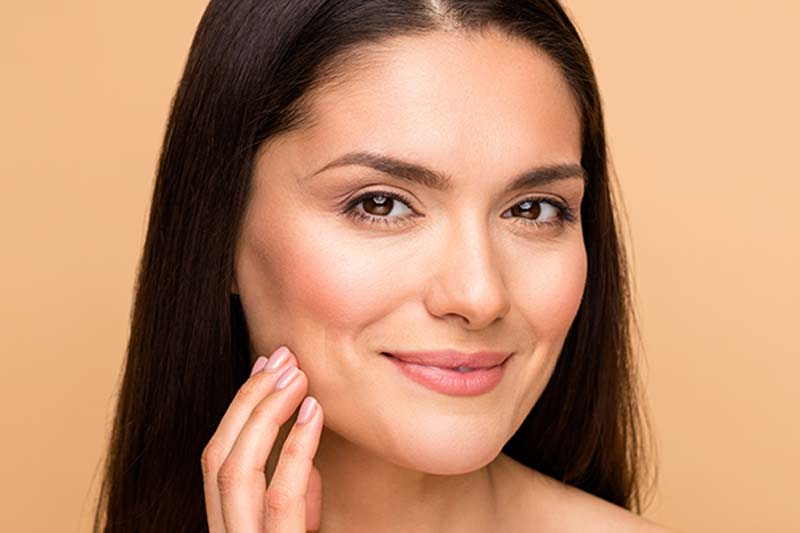Full, rounded cheeks are a characteristic feature of a youthful face. As we age, collagen, elastin, and hyaluronic acid that give our skin support and volume break down. Once firm and supple cheeks succumb to gravity, becoming thin and hollow.
People who want to restore youthful features often turn to non-surgical cosmetic solutions, and the most popular form of cheek augmentation are dermal fillers.
This article lists the best fillers for cheeks, their intended use, and how long they last.

What Is the Best Filler for Cheeks?
The best filler for cheeks depends on the patient’s facial structure, age, weight, and desired outcome. Fillers for this facial area have a different consistency than fillers for lips, fillers for marionette lines, nasolabial fold fillers, etc. Some dermal fillers for cheeks are formulated specifically for this region, while others are used off-label to volumize the midface area.
Note: Learn more about the process of getting cheek fillers, including what results you can expect, when you can expect them, and how much the procedure costs.
Experienced providers typically use the following filler types to augment and contour the cheeks.
Juvéderm
Juvéderm is among the most popular dermal fillers. It is made from hyaluronic acid and has several products with different formulations and thickness designed for different purposes.
Note: Hyaluronic acid (HA) can also be found in some brands of lip filler. Learn more about hyaluronic acid lip fillers and the overall benefits of HA.
Skin experts typically use FDA-approved Juvéderm Voluma XC for the cheeks. Voluma is thicker than other Juvéderm types, helping to lift the midface area and correct age-related volume loss. The gel-like substance comes with lidocaine to minimize potential pain and discomfort during the treatment.
Voluma is injected directly into the cheeks. Patients usually need one to three syringes per cheek. The injected hyaluronic acid attracts water, plumping, smoothing, and lifting the area. It lasts about one year.
Restylane
Restylane is another popular hyaluronic acid-based filler. There are several Restylane filler types, used for different purposes. Their two FDA-approved cheek fillers are Restylane Lyft and Restylane Contour.
Restylane Lyft is a popular choice for cheek augmentation because it has a thicker consistency and large HA particles, helping to lift and volumize the area. It lasts up to one year.
Restylane Contour also has high lifting power and lasts up to one year. However, it is more flexible than Restylane Lyft, providing softer contours and a more natural expression.
Note: Learn about the differences and similarities between Juvéderm and Restylane.
Versa
Like Juvéderm and Restylane, Revanesse Versa is made from hyaluronic acid. It is a newer dermal filler on the market, with patients reporting fewer side effects (e.g., swelling) than with other HA fillers.
Versa is indicated for use in nasolabial folds, marionette lines, lips, and mental creases (lines above the chin), but many cosmetic providers use it off-label to enhance the cheeks. The expected duration of results is one year.
Radiesse
Radiesse is made from calcium hydroxyapatite particles. They are a synthetic version of the natural material in our bones and teeth. Once injected, they stimulate the production of collagen to volumize flattened cheeks and tighten loose skin. The product is used off-label for this area.
The results of Radiesse for cheek augmentation take longer to appear than those of HA-based fillers, but they last longer – about two years.
Note: Read our article on the differences and similarities between Juvéderm and Radiesse.
Sculptra
Another collagen stimulator, Sculptra is made from poly-L-lactic acid (PLLA) which helps replenish lost collagen and facial volume, providing gradual and natural results. Sculptra is FDA-approved for cheek augmentation and wrinkle elimination. Patients typically experience the filler’s effects for up to two years, and sometimes longer.
Unlike HA-based cheek fillers and Radiesse, which require only one session for long-lasting results, Sculptra patients usually need three treatments during three or four months.
Note: Learn more about the differences and similarities between Radiesse and Sculptra.
How to Choose the Right Type of Dermal Filler for Cheeks?
Medical providers choose cheek fillers for each patient based on their unique characteristics, such as age and the state of their skin. Patients are encouraged to learn more about the differences between fillers and discuss options with their providers.
HA-based fillers are a good solution for first-time patients and those who are unsure about their expectations because hyaluronic acid can be dissolved if the patient isn’t happy with the outcome.
Note: Learn how to recognize when too much cheek filler is injected and what the consequences are.
Sculptra is a better choice for patients who want gradual and longer-lasting results.
Note: Bruising is a common side effect of dermal filler treatment that can happen regardless of the brand of filler used. Find out what causes bruising after dermal fillers and how to minimize it.
Conclusion
In the hands of a skilled provider, cheek fillers subtly transform the patient’s appearance to restore the fullness of cheeks characteristic of youth.
Not all dermal fillers are suitable for the midface area. Make sure your provider is a licensed and experienced medical professional who knows how to choose the right product for your needs.
For the best cheek fillers in Phoenix, visit our Vibrant Skin Bar skin experts!


